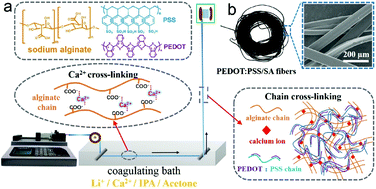Core–shell PEDOT:PSS/SA composite fibers fabricated via a single-nozzle technique enable wearable sensor applications†
Abstract
To improve the mechanical properties of pure poly(3,4-ethylenedioxythiophene):poly(styrene sulfonate) (PEDOT:PSS) fibers with inferior spinnability, sodium alginate (SA) as a modifier was added to the spinning solution to prepare PEDOT:PSS/SA composite fibers with high processability, and they were applicable in various wearable fields. Interestingly, continuous core–shell PEDOT:PSS/SA composite fibers were fabricated via a single-nozzle technique with regular needles instead of coaxial needles. The transparent shell wrapped on the surface of the fibers was proven to be an SA gel. Additionally, the mechanical properties of the composite fibers were opposite in the dry and wet states. The former was strong yet brittle, while the latter was weak yet ductile (typical properties of an SA hydrogel). The presence of SA shells improved the stability and durability of the electroconductive composite fibers. Combined with several simple proof-of-concept experiments, the PEDOT:PSS/SA composite fibers are demonstrated to be a promising candidate for wearable sensors.



 Please wait while we load your content...
Please wait while we load your content...